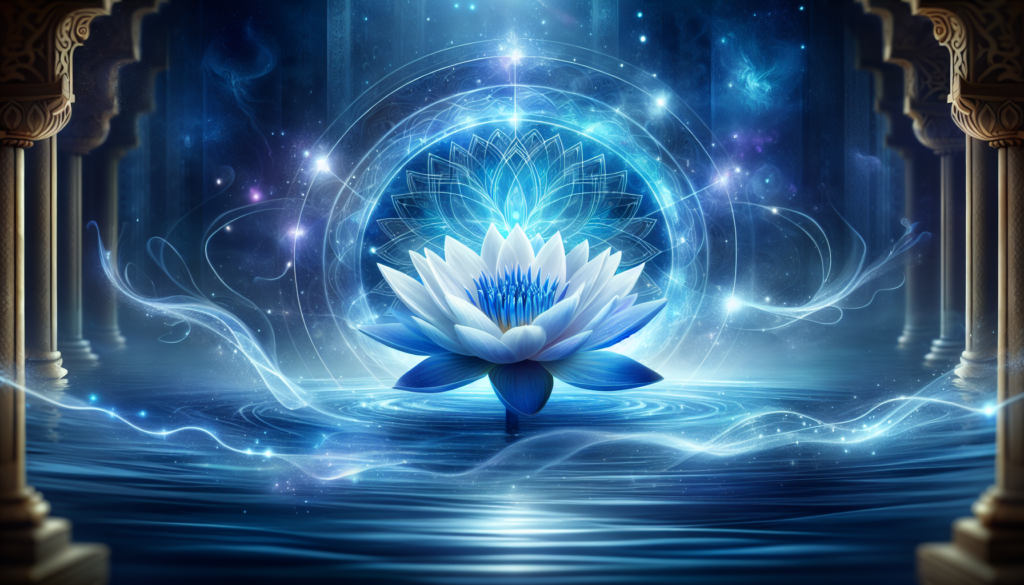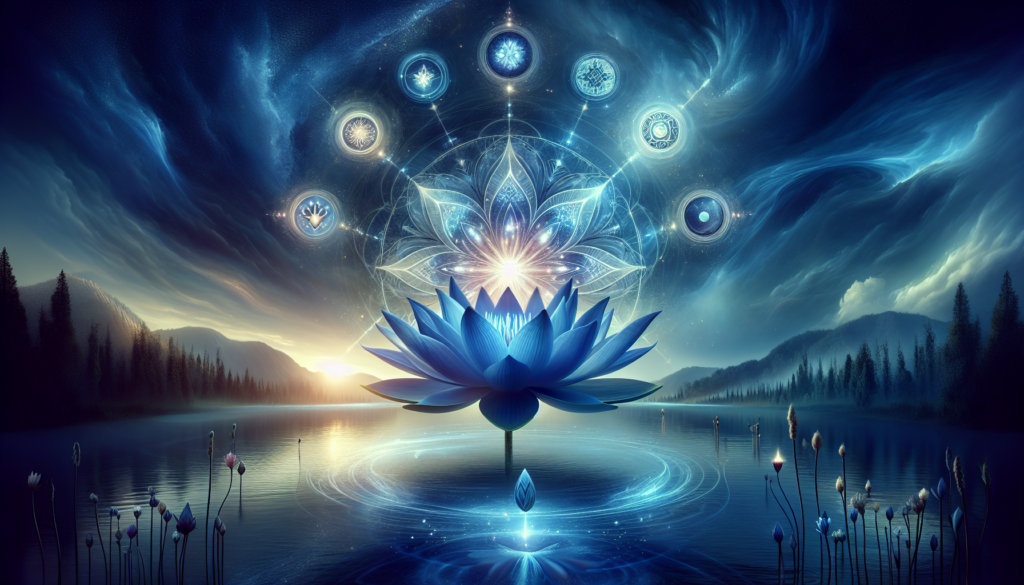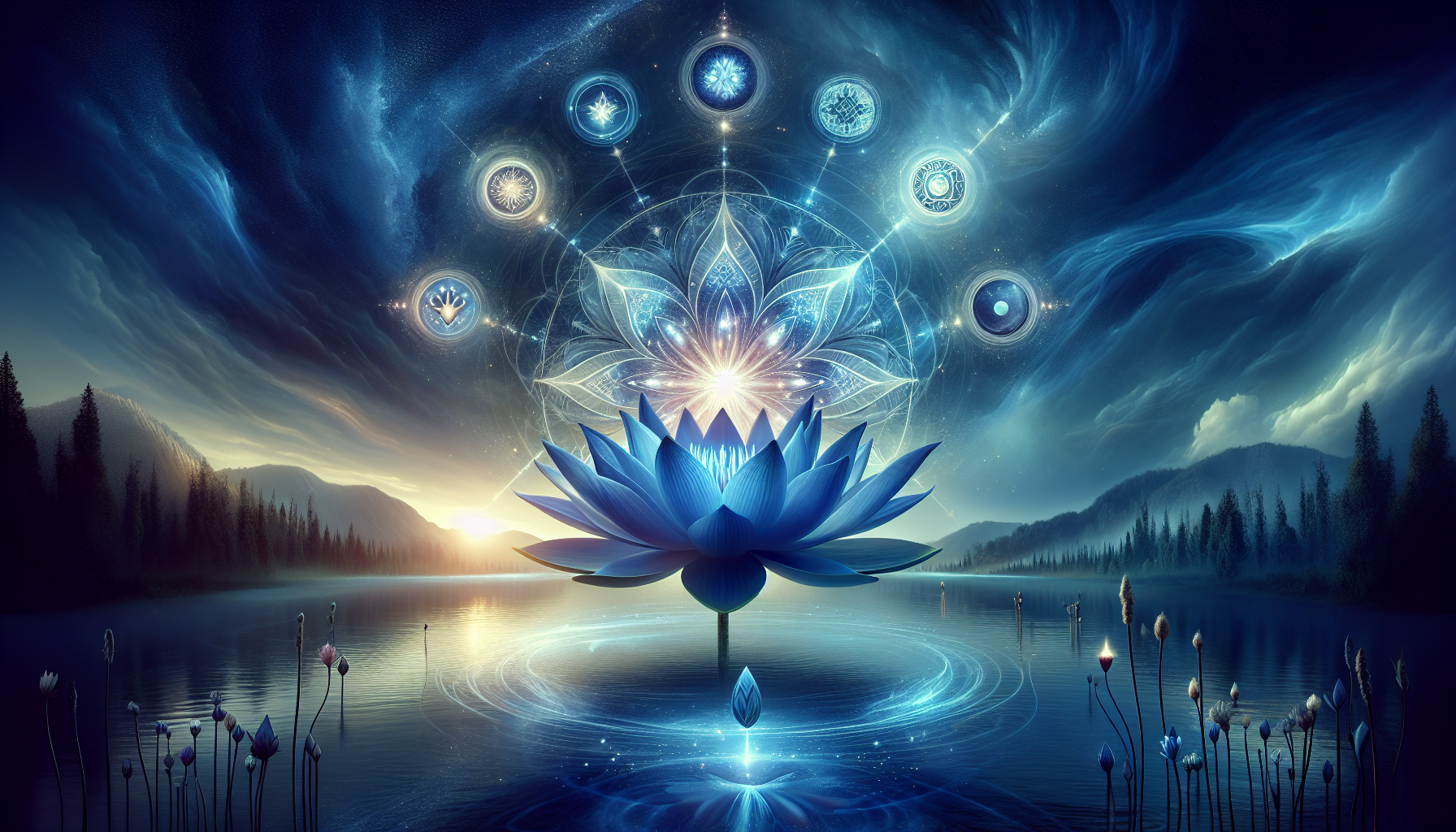Imagine finding a mystical flower that holds profound spiritual benefits. That’s exactly what the blue lotus promises to offer. Known for its vibrant color and captivating fragrance, the blue lotus has been a significant symbol in various cultures throughout history. Its spiritual benefits are said to range from promoting relaxation and tranquility to enhancing meditation and spiritual experiences. In this article, we will explore the spiritual significance of the blue lotus and discover the transformative effects it can have on your spiritual journey.

The Origins of the Blue Lotus
Ancient Egyptian Beliefs
The blue lotus holds a significant place in the ancient Egyptian beliefs and practices. It was considered a symbol of rebirth and creation, as it was believed to emerge from the primordial waters at the beginning of time. The Egyptians associated the blue lotus with the sun god Ra, believing that it had the power to bestow divine wisdom and guidance. The flower was also often depicted in Egyptian art, symbolizing immortality and eternal life.
Importance in Hinduism
In Hinduism, the blue lotus, known as “Neel Kamal,” is highly revered and plays a vital role in religious and spiritual traditions. It is associated with the god Vishnu and the goddess Lakshmi, representing purity, enlightenment, and prosperity. The blue lotus is often depicted in Hindu scriptures and mythology, symbolizing the unfolding of spiritual consciousness and the path to self-realization.
Symbolism in Buddhism
The symbolism of the blue lotus holds great significance in Buddhism. Known as the “Blue Lotus of the Perfect Wisdom,” it represents spiritual enlightenment, purity, and detachment from worldly desires. The lotus is often depicted in Buddhist artworks, where it serves as a reminder that just as the lotus emerges from murky waters, one can rise above suffering and attain spiritual awakening. The blue lotus is also associated with the Buddha himself, symbolizing his divine wisdom and compassionate teachings.
The Medicinal Properties of the Blue Lotus
Sedative and Relaxing Effects
The blue lotus is well-known for its sedative and relaxing effects. It contains alkaloids and compounds that interact with the central nervous system, promoting a sense of calmness and tranquility. Consuming blue lotus preparations or infusions can help alleviate anxiety, stress, and insomnia, allowing for a restful sleep and a rejuvenated mind.
Enhancement of Meditation
For centuries, the blue lotus has been used to enhance meditation practices. Its soothing properties create a conducive environment for deep introspection and inner exploration. The herb has the ability to relax the mind, promote mental clarity, and facilitate a deeper connection to one’s inner self. Many practitioners have reported experiencing enhanced focus and heightened spiritual awareness while incorporating the blue lotus into their meditation rituals.
Aphrodisiac Qualities
In addition to its calming and meditative properties, the blue lotus also possesses aphrodisiac qualities. It is believed to stimulate the libido and enhance sexual experiences. This is due to its ability to increase blood flow and heighten sensations. The blue lotus has been utilized by individuals seeking to ignite their passion, fostering a deeper connection with their partner and celebrating the sacredness of intimacy.
The Spiritual Significance of the Blue Lotus
Awakening and Enlightenment
The blue lotus is deeply intertwined with the journey of awakening and enlightenment. Consuming or meditating with the blue lotus is believed to open spiritual pathways, allowing individuals to tap into higher states of consciousness. It is said to activate the third eye chakra, facilitating intuitive insights, and expanding spiritual awareness. The blue lotus serves as a gentle guide on the path towards self-realization and inner illumination.
Enhanced Intuition and Psychic Abilities
Through its spiritual properties, the blue lotus is believed to enhance intuition and psychic abilities. It is said to heighten one’s sensitivity to subtle energies and enable a deeper connection with the spiritual realm. Utilizing the blue lotus during divination practices or rituals can amplify the intuitive faculties, allowing individuals to access inner wisdom and receive guidance from higher realms.
Connection to Higher Consciousness
The blue lotus acts as a powerful catalyst in establishing a connection with higher consciousness. It is believed to bridge the gap between the physical and spiritual realms, enabling communication with divine beings and spiritual guides. The blue lotus serves as a spiritual ally, helping individuals navigate their spiritual journey and gain insights into the mysteries of existence. By fostering this connection to higher consciousness, the blue lotus encourages spiritual growth and self-transformation.
Ritual and Ceremonial Uses of the Blue Lotus
Sacred Offerings and Devotion
In various spiritual traditions, the blue lotus is offered as a sacred offering to honor deities or spiritual entities. It represents reverence, purity, and devotion. Devotees incorporate the blue lotus into their rituals, placing it on altars or in ceremonial bowls as an act of surrender and gratitude. The presence of the blue lotus during these rituals is believed to invite divine blessings and strengthen the connection between the human and spiritual realms.
Purification and Cleansing
The blue lotus is frequently used in purification and cleansing rituals. Its essence is believed to purify negative energies and cleanse the mind, body, and spirit. Many spiritual practitioners incorporate the blue lotus in sacred baths or use its extracts during smudging ceremonies to create a sacred and energetically pure space. The purifying qualities of the blue lotus are seen as a means to release stagnant energies and invite spiritual clarity.
Divination and Spiritual Guidance
The blue lotus has long been associated with divination and spiritual guidance. Its symbolic connection to higher realms makes it a valuable tool for seekers of spiritual insights. The blue lotus can be utilized during divination practices such as scrying or tarot readings to enhance intuitive abilities and receive messages from the spiritual realm. It is considered a sacred gateway for receiving guidance and illumination on one’s spiritual path.

Historical and Cultural References to the Blue Lotus
Depictions in Art and Literature
Throughout history, the blue lotus has been depicted in various forms of art and literature. Ancient sculptures, paintings, and murals often portray the blue lotus, emphasizing its spiritual and symbolic significance. In literature, the blue lotus is frequently mentioned as a sacred plant with mystical qualities. Its presence in art and literature serves to preserve its spiritual legacy and inspire future generations to explore its profound nature.
References in Ancient Texts
Ancient texts from different cultures and traditions make references to the blue lotus and its spiritual significance. These texts often describe the blue lotus as a mystical plant associated with spiritual awakening, enlightenment, and divine wisdom. The ancient texts contribute to the ongoing reverence and understanding of the blue lotus’s profound spiritual implications.
Traditional Practices and Customs
The blue lotus has been an integral part of traditional practices and customs in many cultures. From ceremonial rituals to religious festivals, the blue lotus has been revered as a sacred symbol of spirituality and transformation. Traditional practitioners incorporate the blue lotus into their customs, passing down ancient wisdom and teachings associated with this mystical flower.
Modern Applications of the Blue Lotus
Alternative Medicine and Holistic Therapies
In modern times, the blue lotus has found its place in alternative medicine and holistic therapies. Its sedative and relaxing effects make it a valuable herb for alleviating stress, anxiety, and insomnia. The blue lotus is often incorporated into herbal teas, tinctures, and essential oils used in aromatherapy practices. Its medicinal properties offer a natural and gentle approach to promoting mental and emotional well-being.
Contemporary Spiritual Practices
The blue lotus continues to be utilized in contemporary spiritual practices. From meditation to energy healing modalities, spiritual seekers integrate the blue lotus into their rituals and ceremonies. The flower’s ability to enhance intuitive abilities and facilitate a connection to higher realms makes it a valuable ally in navigating the complexities of the spiritual journey.
Integration in New Age Movements
The blue lotus has gained popularity within the New Age movement, where it is celebrated for its spiritual and transformative qualities. It is often associated with concepts such as ascension, cosmic consciousness, and vibrational healing. The blue lotus’s ability to facilitate inner growth and expansion aligns with the principles of the New Age movement, making it a cherished tool for those seeking personal and spiritual evolution.
Precautions and Considerations
Potential Side Effects
Although the blue lotus is generally well-tolerated, it is essential to be aware of potential side effects. Excessive consumption of the blue lotus may lead to dizziness, headaches, or digestive discomfort. It is advisable to start with a low dosage and gradually increase to determine individual sensitivity and tolerance. As with any herbal supplement, it is recommended to consult with a healthcare professional before incorporating the blue lotus into your routine.
Interactions with Medications
It is crucial to consider potential interactions between the blue lotus and any medications you may be taking. The flower’s sedative properties may amplify the effects of certain medications, such as sedatives or antidepressants. It is advisable to consult with a healthcare professional or pharmacist to ensure there are no contraindications or adverse interactions with your current medications.
Appropriate Dosage and Administration
When using the blue lotus, it is important to follow the recommended dosage guidelines. Different preparations may have varying strengths, so it’s essential to read and follow the instructions provided by the manufacturer or herbalist. It is also advisable to source the blue lotus from reputable suppliers to ensure the quality and purity of the product. If uncertain about the proper dosage or administration, consult with a knowledgeable herbalist or healthcare professional.
Obtaining and Using the Blue Lotus
Growing and Cultivating
For those interested in cultivating their own blue lotus, it is possible to grow the plant in suitable climates or indoor environments. Blue lotus plants thrive in well-drained soil and require ample sunlight. However, it is important to note that the growth of blue lotus plants may require specific conditions and expertise. It is advisable to consult gardening resources or seek guidance from experienced cultivators.
Dried Flowers and Extracts
If growing the blue lotus is not feasible, dried blue lotus flowers and extracts are readily available for purchase. Dried flowers can be used to prepare herbal teas by infusing them in hot water for several minutes. Extracts, such as tinctures or essential oils, can be utilized in various applications, such as aromatherapy or topical use. It is important to choose high-quality and reputable sources when obtaining dried flowers or extracts to ensure their potency and authenticity.
Preparation and Consumption
When preparing the blue lotus for consumption, it is common to steep dried flowers in hot water to create a tea. The tea can be consumed as is or blended with other herbs for a personalized flavor profile. Alternatively, the dried flowers can be incorporated into culinary creations or used in herbal bath rituals for a soothing and sensory experience. It is important to follow the recommended dosage and preparation techniques to ensure the desired effects.
Personal Experiences and Testimonials
Spiritual Journeys and Transformations
Many individuals have reported profound spiritual experiences and transformative journeys with the blue lotus. It has been credited with facilitating deep inner healing, enlightenment, and expanded consciousness. Individuals have expressed experiencing a sense of connectedness to the universe, heightened intuition, and a greater understanding of their life’s purpose. The blue lotus has become a cherished ally for those seeking spiritual growth and transformation.
Profound Insights and Realizations
Using the blue lotus as a spiritual tool has led individuals to profound insights and realizations. It is often described as opening doors to hidden realms of consciousness and unlocking the mysteries of the self and existence. Through the blue lotus, individuals have gained clarity on personal challenges, healed past traumas, and discovered the interconnectedness of all beings. These experiences have provided a deep sense of purpose and direction in their spiritual journey.
Healing and Inner Balance
The blue lotus is frequently attributed to promoting healing and inner balance. Individuals have shared experiences of emotional healing, releasing blockages, and finding inner peace and contentment. The flower’s calming properties have aided in reducing anxiety and restoring a sense of equilibrium in turbulent times. Through the blue lotus’s spiritual and medicinal qualities, individuals have discovered a path towards holistic well-being and self-discovery.
Conclusion
The blue lotus is a remarkable flower with a rich spiritual heritage. From ancient civilizations to contemporary practices, its significance has endured. Whether seeking tranquility, spiritual insight, or personal transformation, the blue lotus offers a gentle yet profound journey towards self-realization and connection with higher consciousness. However, while embracing the blue lotus’s potential benefits, it is essential to exercise caution, respect its potency, and integrate it into spiritual practices with reverence and mindfulness. The blue lotus remains a gateway to a deeper understanding of oneself and the interconnectedness of all existence.


